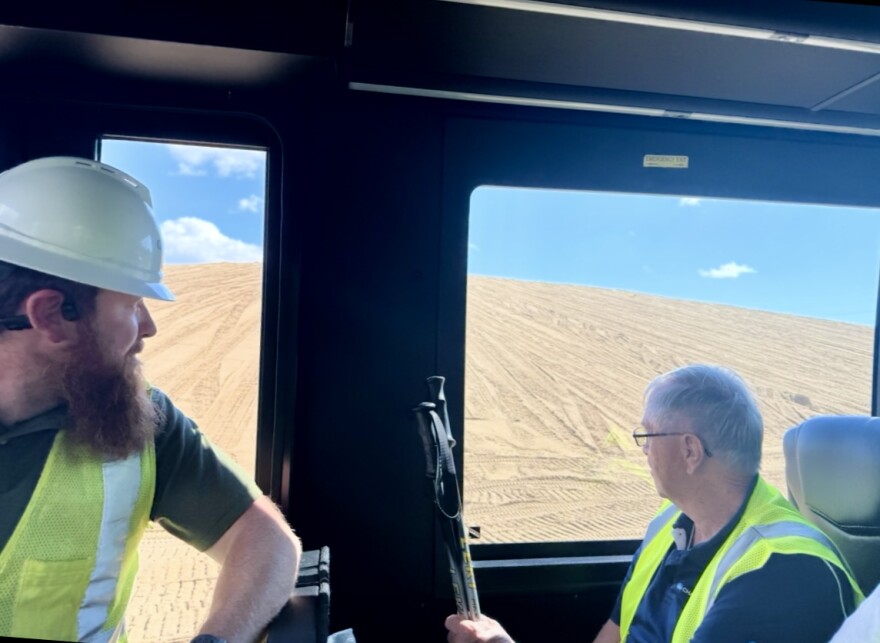In Kalamazoo off Cork Street sits a moonscape that used to be home to paper mills owned by Allied Paper. Where the Bryant and Monarch mills once sat is now a cleanup site, which the federal government put in the Superfund program due to the presence of paper waste and industrial chemicals called PCBs. Cleanup began in 2021. Today, it looks like a huge dirt hill surrounded by embankments.
The U.S. Environmental Protection Agency is in charge of the cleanup and contracts with several engineering, construction and consulting firms for work on the site. On August 28, the EPA invited visitors to tour it and see the progress being made.

Visitors gathered near the front of the site at 268 E Alcott Street for a presentation before filing onto buses and riding up to the top of the dirt hill toward the center. At the top of the hill, dump trucks could be seen being loaded with contaminated soil and offloading it into a central area.
Ben Giese is a scientist and site manager for Geosyntec consultants, which is working on the site and consulting on the construction of the permanent landfill. The goal is to secure the contaminants in a central area where they can’t get into the surrounding environment. Giese said to think of the finished product like a jelly donut, where the jelly represents contaminants.
“The embankment itself is nice, solid, compacted, tested, very geotechnically sound — that's the donut itself. Then we have some jelly which will be coming over from Monarch or elsewhere, other material that we've got. And what we're pulling out right now is also jelly going in the middle. So it's just a firm exterior for a nice soft middle to keep everything contained,” Giese said.
Once all of the contaminants, or jelly, are relocated, the “donut” will be sealed off by placing a large plastic cap over the contaminants, covering it with several feet of soil, and planting fresh grass.

Jim Saric is a Superfund project manager with the EPA and oversees the entire Superfund site. He said once the construction is complete, the EPA will continue to monitor the site to make sure the contaminants aren’t migrating out of the secure area.
“The concept is we're constructing it, particularly the cover, pretty typical of what you would find in a lot of other landfills, how it's going to be constructed on top. There'll be a ground water monitoring system there. There'll be annual maintenance. They'll be mowing,” Saric said.
Once the remediation is complete, Saric said the city of Kalamazoo will most likely take ownership of the land and have the authority to decide what the site is used for. Though the land is prohibited from being used for residential purposes, Giese said the ultimate goal is to make the area safe for people and wildlife.
“The vegetation or the grass gets established on top of it. You mow it a couple times a year to make sure no trees are rooting and growing through it. And there's a very specific inspection process for things like that that you're looking for. Making sure animals aren't burrowing through it,” Giese said.

Officials at the site said cleanup is expected to be completed sometime in 2028. But the project as a whole will take longer, as the property is part of a larger Superfund site called the Allied Paper, Inc./Portage Creek/Kalamazoo River Superfund Site.
Portage Creek, which runs into the Kalamazoo River, used to flow freely through the site. Now it’s diverted and contaminated by runoff; the section near the site is not safe for swimming or fishing. Saric said one goal of the landfill remediation is to restore Portage Creek enough to hopefully deem it safe for recreation once again.
“They're going to kind of redesign that creek so it doesn't potentially impact this landfill, but it's going to kind of be free to kind of meander in this valley,” Saric said.

David Maturen was one of the local residents on the tour. He’s the president of the Michigan Lakes and Streams Association and said he was interested in seeing the work done on Portage Creek.
“We have a concern for all of our inland waterways and Portage Creek is obviously one of them. So, I want to, you know, see how far they've come with progressing to bring the creek back to fishable, habitable,” Maturen said.
Coco Soodek, who lives on Lake Allegan part of the time, is part of the Kalamazoo River Superfund Community Advisory Group. Soodek said the CAG exists for members to weigh in on the ongoing cleanup efforts along the river.
“We're here to help the public learn about it, voice their concerns about the river, and love the river, and make it better, and make it cleaner and healthier” Soodek said.

Many of the people who came on the tour were local residents who live near the site, but stakeholders and city officials were also present. Soodek said the CAG is made up of both, but added that anyone interested in learning more about the Superfund site or river-related cleanup projects is welcome to join.
“The thing about living on a river is you get to take care of it. You get to learn about it and we're here to learn about it, to talk to the government people who are actually here working on the river,” Soodek said.






